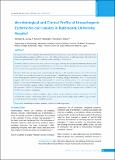Please use this identifier to cite or link to this item:
https://hdl.handle.net/20.500.14356/1733| Title: | Microbiological and Clinical Profile of Uropathogenic Escherichia coli Isolates in Kathmandu University Hospital |
| Authors: | Sherchan, J B Gurung, P Karkee, P Ranabhat, N Shrestha, N Ohara, H |
| Citation: | SherchanJ. B., GurungP., KarkeeP., RanabhatN., ShresthaN., & OharaH. (2016). Microbiological and Clinical Profile of Uropathogenic Escherichia coli Isolates in Kathmandu University Hospital. Journal of Nepal Health Research Council. https://doi.org/10.33314/jnhrc.v0i0.722 |
| Issue Date: | 2016 |
| Publisher: | Nepal Health Research Council |
| Article Type: | Original Article |
| Keywords: | Extended Spectrum Beta-Lactamase Escherichia coli Multidrug resistant |
| Series/Report no.: | Jan-April, 2016;722 |
| Abstract: | Abstract Background: Treatment of patients infected by multidrug resistant bacteria is a major challenge. Immunocompromised status, prolonged hospital stay, malignancy, diabetes are some of the risk factors for emergence of multidrug resistance. Our study focused on microbiological and clinical profile of multidrug resistant uropathogenic Escherichia coli. Methods: This was a cross-sectional study conducted between June 2014-May 2015 in Kathmandu University Hospital. Urine sample from outpatients and inpatients from which Escherichia coli isolated was included. Specimen collection, culture, identification tests were done following guidelines given by American Society for Microbiology. Results: Total number of urine samples received during the study were 3,554. Escherichia coli isolates were 645(18.14%) and 245(37.98%) were Extended Spectrum Beta-Lactamase producer. Extended Spectrum Beta-Lactamase producers were found more among inpatients 148(60.41%) [p<0.001], patients with underlying urological abnormalities 38 (15.51%) [p=0.0039], pregnant ladies 46(18.77%) [p=0.0028], diabetic patients 27 (11.02%) [p=0.0084], patients who received prior antibiotic therapy 155 (63.26%) [p=0.0043] than Extended Spectrum Beta-Lactamase non-producer. Malignancy was seen more among Extended Spectrum Beta-Lactamase producer having patients 5 (2.04%) [p=0.031] and all these isolates were more resistant to fluoroquinolones 168(68.57%), Trimethoprim-sulfamethoxazole 239 (97.55%) [p=0.0633], aminoglycosides [p=0.0001] but only 2(0.80%) were resistant to carbapenems. Conclusions: Diabetes, pregnancy, malignancy, prior antibiotic therapy, underlying urological abnormalities were found associated with emergence of Extended Spectrum Beta-Lactamase producer in urine samples. Proper antibiotic usage may help to overcome the problem of emergence of antibiotic resistance. Keywords: Extended Spectrum Beta-Lactamase, Escherichia coli, multidrug resistant. |
| Description: | Original Article |
| URI: | http://103.69.126.140:8080/handle/20.500.14356/1733 |
| ISSN: | Print ISSN: 1727-5482; Online ISSN: 1999-6217 |
| Appears in Collections: | Vol. 14 No. 1 Issue 32 Jan - Apr 2016 |
Files in This Item:
| File | Description | Size | Format | |
|---|---|---|---|---|
| 722-Article Text-1357-5-10-20160609.pdf | Fulltext Download | 211.96 kB | Adobe PDF |  View/Open |
Items in DSpace are protected by copyright, with all rights reserved, unless otherwise indicated.
